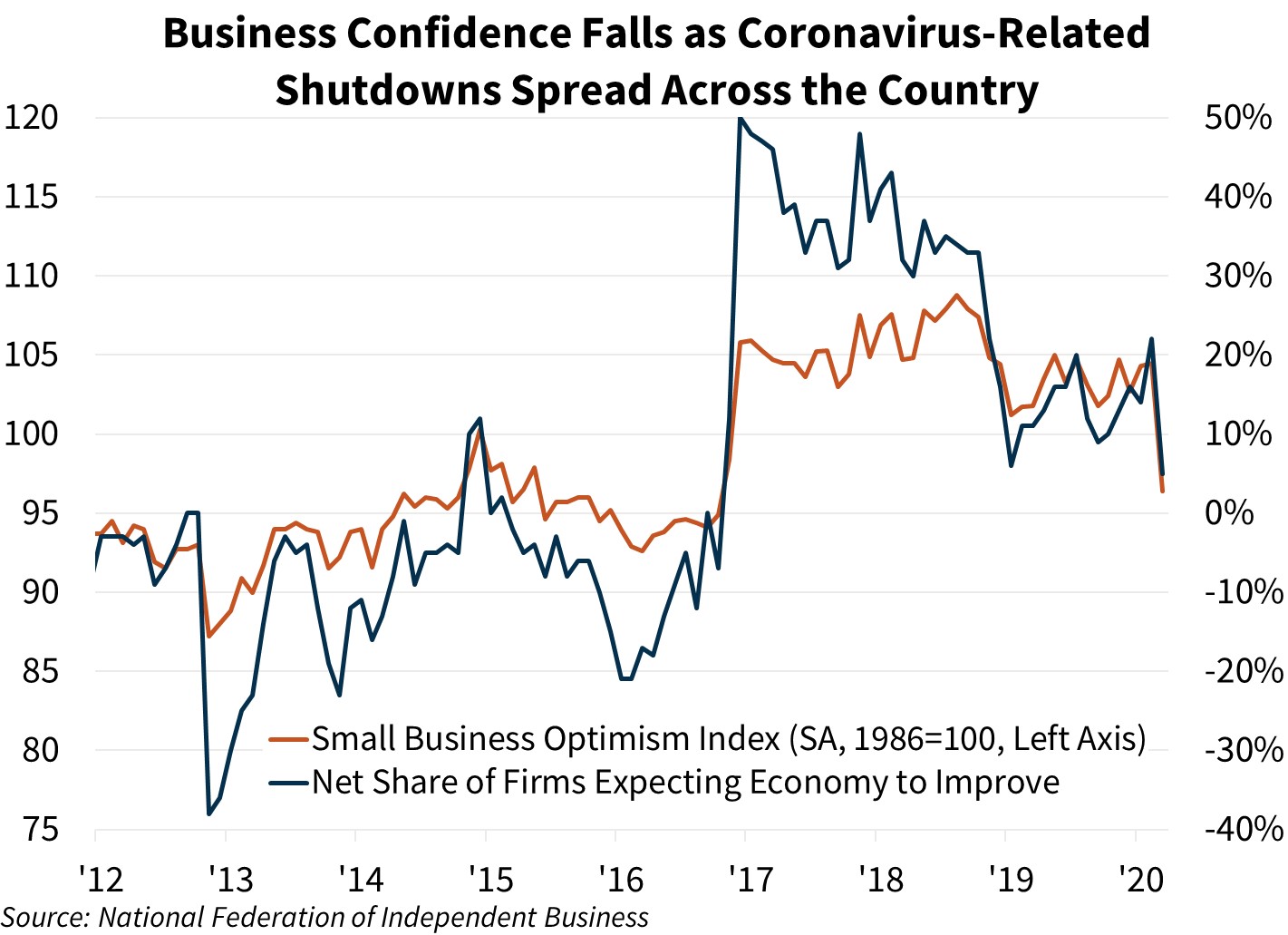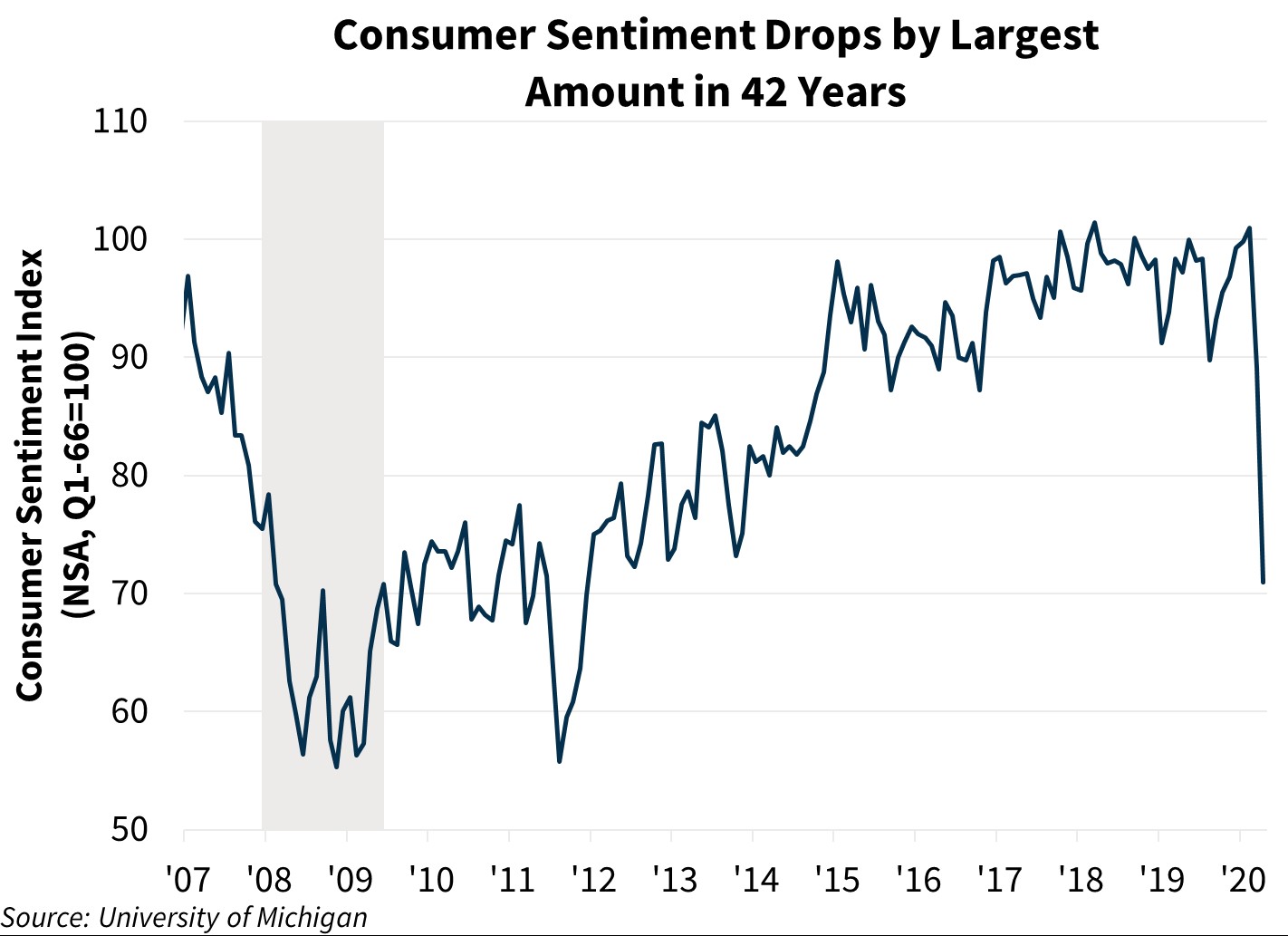Consumer and Business Confidence Fall in Response to the Coronavirus
Key Takeaways:
- The Federal Open Market Committee (FOMC) minutes from its emergency meeting on March 15, in which the committee decided to lower the federal funds rate target by 100 basis points to a range of 0.00-0.25 percent, show that that meeting participants “viewed the near-term economic outlook as having deteriorated sharply…and as having become profoundly uncertain.” Participants also noted that the housing market was likely to be disrupted by contagion avoidance behaviors and by household financial stress. On April 9, the Federal Reserve also announced an additional $2.3 trillion in loans to assist households and employers, as well as state and local governments. These loan programs should improve the flow of credit and slow the deterioration of small business and household confidence.
- The National Federation of Independent Business (NFIB) Small Business Optimism Index fell by 8.1 points in March to 96.4, the largest decline in the survey’s 34-year history. The net share of firms planning to increase employment fell 12 percentage points to just 9 percent, while the net share of firms expecting real sales to be higher fell sharply, declining 31 percentage points to negative 12 percent, the lowest share since August 2011.
- The University of Michigan Consumer Sentiment Index dropped 18.1 points to 71.0 in the preliminary April reading, the largest monthly decline in the survey’s 42-year history and the lowest level since December 2011. The current economic conditions index also posted a record monthly decline.
- The Consumer Price Index (CPI) rose 1.5 percent in March from a year ago, decelerating eight-tenths from February’s pace. The deceleration was largely driven by energy prices, which fell 5.7 percent year over year, the largest annual decline in energy prices since oil prices collapsed between 2014 and 2015. Core CPI (excluding food and energy prices) grew 2.1 percent annually, decelerating three-tenths from February.
- Mortgage applications fell 17.9 percent for the week ending April 3, according to the Mortgage Bankers Association. Both refinance and purchase applications dropped sharply, falling 19.4 percent and 12.2 percent, respectively. Purchase applications fell to the lowest level since October 2015.
Forecast Impact
The escalation of COVID-19 has had a substantial effect on consumer and business sentiment as states shut down all non-essential businesses and most consumers remain at home. The large declines in small business sentiment in March and consumer sentiment in April are likely only the beginning, and we expect sentiment to deteriorate further in the second quarter, partially contributing to losses in business fixed investment and consumer spending. The deceleration of headline CPI in March was driven entirely by a decline in energy prices as crude oil prices continued to fall; we believe oil prices will remain low and volatile this year as demand slows. Residential and commercial real estate will also likely be impacted by the drops in both consumer and business sentiment, which we expect will suppress sales and the demand for new construction in the coming months as consumers and businesses face widespread financial and economic uncertainty. We have already seen declining demand for purchase mortgage applications, a trend which will likely continue until infection-avoidance behaviors ease.


Details on Key Takeaways and Other Releases
- The National Federation of Independent Business (NFIB) Small Business Optimism Index fell by 8.1 points in March to 96.4. According to the accompanying report, an additional NFIB survey sent out in March found that “92 percent of small employers are negatively impacted by the outbreak [of coronavirus] and about half of small employers said they can survive for no more than two months under the current business conditions.”
- The University of Michigan Consumer Sentiment Index dropped 18.1 points to 71.0 in the preliminary April reading. The current economic conditions index fell 31.3 points to 72.4. The consumer expectations index fell 9.7 points to 70.0, the lowest reading since March 2014. Inflation expectations for the next five years rose two-tenths to 2.5 percent.
- Headline CPI fell 0.4 percent in March, the first decline since May 2017, according to the Bureau of Labor Statistics. Core CPI dipped 0.1 percent, the first decline since January 2010, driven by declines in apparel and new vehicle prices. From a year ago, headline CPI rose 1.5 percent, while core CPI rose 2.1 percent. For headline CPI, this is the slowest annual pace of growth in about a year, and for core CPI, the slowest annual pace of growth since June 2019. It should be noted that due to the coronavirus, there was “an increase in the number of prices being considered temporarily unavailable and imputed” due to the cancellation of in-person visits and the number of establishments which were temporarily closed.
- Consumer (non-mortgage) credit outstanding increased $22.3 billion to $4.2 trillion in February, according to the Federal Reserve Board. Revolving credit (largely credit cards) rose $4.2 billion, while non-revolving credit (largely student and auto loans) jumped $18.1 billion, the largest increase since September 2015.
Economic and Strategic Research Group
April 10, 2020
Opinions, analyses, estimates, forecasts and other views of Fannie Mae's Economic and Strategic Research (ESR) Group included in these materials should not be construed as indicating Fannie Mae's business prospects or expected results, are based on a number of assumptions, and are subject to change without notice. How this information affects Fannie Mae will depend on many factors. Although the ESR group bases its opinions, analyses, estimates, forecasts and other views on information it considers reliable, it does not guarantee that the information provided in these materials is accurate, current or suitable for any particular purpose. Changes in the assumptions or the information underlying these views could produce materially different results. The analyses, opinions, estimates, forecasts and other views published by the ESR group represent the views of that group as of the date indicated and do not necessarily represent the views of Fannie Mae or its management.
